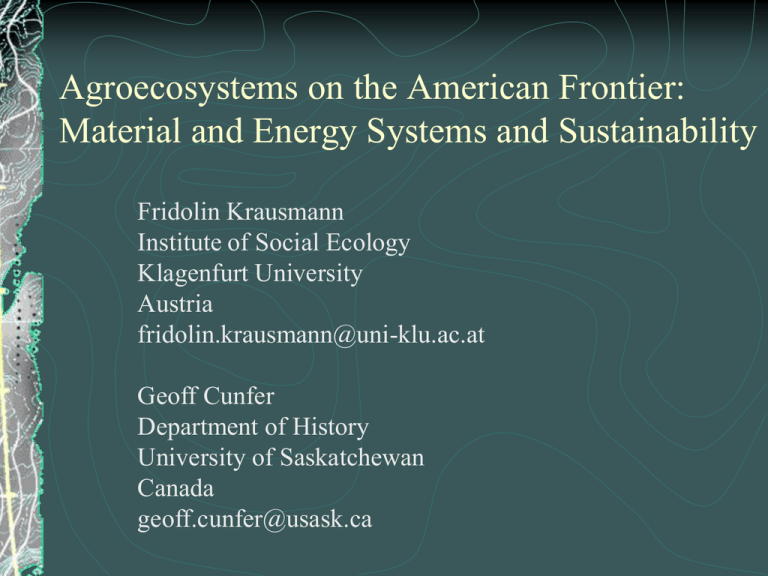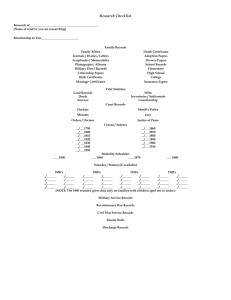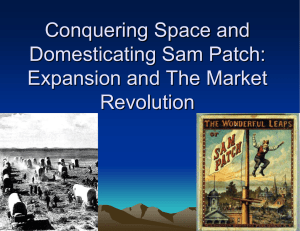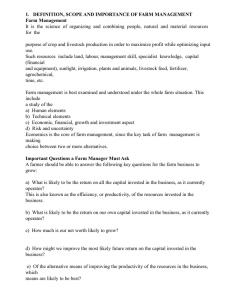
Agroecosystems on the American Frontier:
Material and Energy Systems and Sustainability
Fridolin Krausmann
Institute of Social Ecology
Klagenfurt University
Austria
fridolin.krausmann@uni-klu.ac.at
Geoff Cunfer
Department of History
University of Saskatchewan
Canada
geoff.cunfer@usask.ca
1910
1900
1890
1880
1870
1860
1850
1840
1830
1820
1600
1810
1800
[1000 P]
US immigration
1200
800
400
0
1910
1900
1890
1880
1870
1860
1850
1840
1830
1820
1810
1800
[1000 t]
5000
Cereal exports
4000
3000
2000
1000
0
George Thir and Elizabeth Demmer migration
from Austria-Hungary to Kansas, 1880s
Gols, Zurndorf, Ragendorf, Kaltenstein
homestead in Decatur County, 1884
built a family, a farm, and an agro-ecosystem,
1885-1940
Q. How did the farm system that the Thirs left
behind compare with that which they found (and
created) on the Great Plains frontier?
Comparative case studies:
Theyern, Austria, 1829
Finley Township, Decatur County, Kansas, 1885-1940
Social metabolism approach
Key socio-ecological indicators
Metabolic relationships in agricultural
production systems
Local socio-ecological system
Agroecosystem
Woodland
Grassland
Production
Population
Work
Work
Livestock
Draft
power
Biomass
Cropland
Manure
Material / energy
Farmsteads and
infrastrcture
Machines and
tools
Food
Energy
Import / export
Human
population with
certain
characteristics:
Age structure
Fertility
Mortality
…
Work / migration
Village farm settlement, Theyern, Lower Austria, 2002
Franciscean Cadastre, Theyern, Austria, 1829
land use & land cover map
land ownership
textual description of farm
system and productivity
quantitative data
yields
livestock
demography
taxes
Theyern land use, 1829
Land use, Theyern 1829
Pasture, meadows and fruit gardens
Cropland
Woodlands
All other land
Area: 225 ha
Population: 102
Farms: 17
300
0
N
300
600 Meters
Theyern 3-field rotation & dispersed fields, 1829
Three field rotation system, Theyern 1829
Field A (Hochgeit/Kleinfeld/Ortsried)
Field B (Fahrenfeld/Mittelfeld)
Field C (Bodenfeld/Taubenfeld)
Woodland
Dispersed fields of Gill Farm
300
0
300
N
600 Meters
Consolidated farms
Finley Township
Decatur County
Kansas
1921
Rural farm settlement in Finley Township, 2004
Census Manuscripts, Kansas, 1885-1940
9 snapshots of farm and family
Land use
crop acreage & production
livestock
fencing, irrigation, tractors
Demography
name, age, sex, literacy
birthplace, parents’ birthplace, mother tongue
Nested scales
farm
township
county
Key socio-ecological indicators
People and Space
population density
land availability
Farm Productivity
grain yield
area productivity
labor productivity
marketable crop production
Livestock and Nutrient Management
livestock density
nitrogen return
People and Space: Population Density
50
Finley Tow nship
Thir farm
population density [cap/km²]
40
Theyern community
30
20
10
1950
1940
1930
1920
1910
1900
1890
1880
1870
1860
1850
1840
1830
1820
0
Theyern: land was scarce, but labor was abundant.
Finley Township: labor was scarce and land was abundant
People and Space: Land Availability
100
[ha farmland/cap]
75
50
25
1950
1940
1930
1920
1910
1900
1890
1880
1870
1860
1850
1840
1830
1820
0
Theyern: shortage of arable land
Finley Township: shortage of labor to work the land
Farm Productivity: Grain Yield
1800
Finley Tow nship
Thir farm
grain yield [kg/ha]
Theyern community
1200
600
1950
1940
1930
1920
1910
1900
1890
1880
1870
1860
1850
1840
1830
1820
0
Theyern: considerable yields, rising through 19th century
Finley Township: very high yields, falling sharply
8
6
4
2
1950
1940
1930
1920
1910
1900
1890
1880
1870
1860
1850
1840
1830
0
1820
Food output per unit of farm land [GJ food / ha]
Farm Productivity: Area Productivity
Similar area productivity in Theyern and Finley Township.
Large fluctuations in Kansas due to variable rainfall.
400
300
200
100
1950
1940
1930
1920
1910
1900
1890
1880
1870
1860
1850
1840
1830
0
1820
Food output per agricultural laborer [GJ food / cap]
Farm Productivity: Labor Productivity
Theyern: 1 laborer fed 2.5 people
Finley Township: 1 laborer fed 100 people (1930)
Farm Productivity: Marketable Crop Production
[% of biomass extracted (tons dry matter)]
100
75
50
25
1950
1940
1930
1920
1910
1900
1890
1880
1870
1860
1850
1840
1830
1820
0
Finley Township’s excess production was exported to urban,
industrializing parts of the eastern US, UK, & western Europe.
Livestock & Nutrient Management: Livestock Density
livestock density [animal units/km²]
30
20
10
Finley Tow nship
Thir farm
Theyern community
1950
1940
1930
1920
1910
1900
1890
1880
1870
1860
1850
1840
1830
1820
0
Theyern: multi-use animals—food, waste recycling, power, manure
Finley: specialized animals—power (horses), grazing (cattle)
Livestock & Nutrient Management: Nitrogen Return
75
50
25
1950
1940
1930
1920
1910
1900
1890
1880
1870
1860
1850
1840
1830
0
1820
nitrogen return [% of extracted N returned to soil]
100
Theyern: near 100% N return, using livestock manure
Finley Township: 20-40% N return: soil mining
Long term trends in grain yield:
Austria and Kansas, 1830-1940
300
Kansas
250
[t/km²]
200
150
100
Austria
50
1940
1930
1920
1910
1900
1890
1880
1870
1860
1850
1840
1830
0
Austria: Yield increases: optimization of low input farming
Kansas: Declining yields: stock depletion; large fluctuations
Conclusions
Resource efficiencies
Theyern: labor abundance for long-term subsistence
(risk minimization)
Finley Township: fertile land abundance for market
production (improved standards of living)
Both efficient in own way
19th century trajectories
Theyern: increasing yields
Finley Township: declining yields (soil crisis by 1930s)
20th century convergence: replacing soil with oil
fossil fuels solved soil crisis in Kansas
yields skyrocketed in both places by 2000









